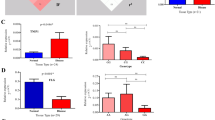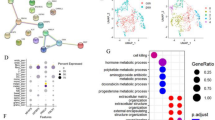Abstract
Previous studies have identified 41 independent genome-wide significant psoriasis susceptibility loci. After our first psoriasis genome-wide association study, we designed a custom genotyping array to fine-map eight genome-wide significant susceptibility loci known at that time (IL23R, IL13, IL12B, TNIP1, MHC, TNFAIP3, IL23A and RNF114) enabling genotyping of 2269 single-nucleotide polymorphisms (SNPs) in the eight loci for 2699 psoriasis cases and 2107 unaffected controls of European ancestry. We imputed these data using the latest 1000 Genome reference haplotypes, which included both indels and SNPs, to increase the marker density of the eight loci to 49 239 genetic variants. Using stepwise conditional association analysis, we identified nine independent signals distributed across six of the eight loci. In the major histocompatibility complex (MHC) region, we detected three independent signals at rs114255771 (P=2.94 × 10−74), rs6924962 (P=3.21 × 10−19) and rs892666 (P=1.11 × 10−10). Near IL12B we detected two independent signals at rs62377586 (P=7.42 × 10−16) and rs918518 (P=3.22 × 10−11). Only one signal was observed in each of the TNIP1 (rs17728338; P=4.15 × 10−13), IL13 (rs1295685; P=1.65 × 10−7), IL23A (rs61937678; P=1.82 × 10−7) and TNFAIP3 (rs642627; P=5.90 × 10−7) regions. We also imputed variants for eight HLA genes and found that SNP rs114255771 yielded a more significant association than any HLA allele or amino-acid residue. Further analysis revealed that the HLA-C*06-B*57 haplotype tagged by this SNP had a significantly higher odds ratio than other HLA-C*06-bearing haplotypes. The results demonstrate allelic heterogeneity at IL12B and identify a high-risk MHC class I haplotype, consistent with the existence of multiple psoriasis effectors in the MHC.
Similar content being viewed by others
Log in or create a free account to read this content
Gain free access to this article, as well as selected content from this journal and more on nature.com
or
Accession codes
References
Elder JT, Bruce AT, Gudjonsson JE et al: Molecular dissection of psoriasis: integrating genetics and biology. J Invest Dermatol 2010; 130: 1213–1226.
Yates VM, Watkinson G, Kelman A : Further evidence for an association between psoriasis, Crohn's disease and ulcerative colitis. Br J Dermatol 1982; 106: 323–330.
Ellinghaus D, Ellinghaus E, Nair RP et al: Combined analysis of genome-wide association studies for Crohn disease and psoriasis identifies seven shared susceptibility loci. Am J Hum Genet 2012; 90: 636–647.
Nair RP, Duffin KC, Helms C et al: Genome-wide scan reveals association of psoriasis with IL-23 and NF-kappaB pathways. Nat Genet 2009; 41: 199–204.
Genetic Analysis of Psoriasis Consortium, Wellcome Trust Case Control Consortium 2, Strange A et al: A genome-wide association study identifies new psoriasis susceptibility loci and an interaction between HLA-C and ERAP1. Nat Genet 2010; 42: 985–990.
Stuart PE, Nair RP, Ellinghaus E et al: Genome-wide association analysis identifies three psoriasis susceptibility loci. Nat Genet 2010; 42: 1000–1004.
Tsoi LC, Spain SL, Knight J et al: Identification of 15 new psoriasis susceptibility loci highlights the role of innate immunity. Nat Genet 2012; 44: 1341–1348.
Knight J, Spain SL, Capon F et al: Conditional analysis identifies three novel major histocompatibility complex loci associated with psoriasis. Hum Mol Genet 2012; 21: 5185–5192.
Capon F, Bijlmakers MJ, Wolf N et al: Identification of ZNF313/RNF114 as a novel psoriasis susceptibility gene. Hum Mol Genet 2008; 17: 1938–1945.
Nair RP, Stuart PE, Nistor I et al: Sequence and haplotype analysis supports HLA-C as the psoriasis susceptibility 1 gene. Am J Hum Genet 2006; 78: 827–851.
Fan X, Yang S, Huang W et al: Fine mapping of the psoriasis susceptibility locus PSORS1 supports HLA-C as the susceptibility gene in the Han Chinese population. PLoS Genet 2008; 4: e1000038.
Feng BJ, Sun LD, Soltani-Arabshahi R et al: Multiple Loci within the major histocompatibility complex confer risk of psoriasis. PLoS Genet 2009; 5: e1000606.
Genomes Project C, Abecasis, Auton A et al: An integrated map of genetic variation from 1,092 human genomes. Nature 2012; 491: 56–65.
Carlson CS, Eberle MA, Rieder MJ, Yi Q, Kruglyak L, Nickerson DA : Selecting a maximally informative set of single-nucleotide polymorphisms for association analyses using linkage disequilibrium. Am J Hum Genet 2004; 74: 106–120.
Thomson W, Barton A, Ke X et al: Rheumatoid arthritis association at 6q23. Nat Genet 2007; 39: 1431–1433.
Plenge RM, Cotsapas C, Davies L et al: Two independent alleles at 6q23 associated with risk of rheumatoid arthritis. Nat Genet 2007; 39: 1477–1482.
Abecasis GR RelativeFinder. Software Package.
Li Y, Willer CJ, Ding J, Scheet P, Abecasis GR : MaCH: using sequence and genotype data to estimate haplotypes and unobserved genotypes. Genet Epidemiol 2010; 34: 816–834.
Howie B, Fuchsberger C, Stephens M, Marchini J, Abecasis GR : Fast and accurate genotype imputation in genome-wide association studies through pre-phasing. Nat Genet 2012; 44: 955–959.
Jia X, Han B, Onengut-Gumuscu S et al: Imputing amino acid polymorphisms in human leukocyte antigens. PLoS One 2013; 8: e64683.
Kang HM, Sul JH, Service SK et al: Variance component model to account for sample structure in genome-wide association studies. Nat Genet 2010; 42: 348–354.
Devlin B, Roeder K : Genomic control for association studies. Biometrics 1999; 55: 997–1004.
Purcell S, Neale B, Todd-Brown K et al: PLINK: a tool set for whole-genome association and population-based linkage analyses. Am J Hum Genet 2007; 81: 559–575.
Falconer DS : The inheritance of liability to certain diseases, estimated from the incidence among relatives. Ann Hum Genet 1965; 29: 51–76.
So HC, Gui AH, Cherny SS, Sham PC : Evaluating the heritability explained by known susceptibility variants: a survey of ten complex diseases. Genet Epidemiol 2011; 35: 310–317.
So HC, Sham PC : Effect size measures in genetic association studies and age-conditional risk prediction. Hum Hered 2010; 70: 205–218.
Wang K, Li M, Hakonarson H : ANNOVAR: functional annotation of genetic variants from high-throughput sequencing data. Nucleic Acids Res 2010; 38: e164.
Karolchik D, Barber GP, Casper J et al: The UCSC Genome Browser database: 2014 update. Nucleic Acids Res 2014; 42: D764–D770.
Pruitt KD, Brown GR, Hiatt SM et al: RefSeq: an update on mammalian reference sequences. Nucleic Acids Res 2014; 42: D756–D763.
Consortium EP: The ENCODE (ENCyclopedia Of DNA Elements) Project. Science 2004; 306: 636–640.
Ernst J, Kellis M : ChromHMM: automating chromatin-state discovery and characterization. Nat Methods 2012; 9: 215–216.
Pollock R, Chandran V, Barrett J et al: Differential major histocompatibility complex class I chain-related A allele associations with skin and joint manifestations of psoriatic disease. Tissue Antigens 2011; 77: 554–561.
Jenisch S, Henseler T, Nair RP et al: Linkage analysis of human leukocyte antigen (HLA) markers in familial psoriasis: strong disequilibrium effects provide evidence for a major determinant in the HLA-B/-C region. Am J Hum Genet 1998; 63: 191–199.
Manolio TA, Collins FS, Cox NJ et al: Finding the missing heritability of complex diseases. Nature 2009; 461: 747–753.
Potaczek DP, Kabesch M : Current concepts of IgE regulation and impact of genetic determinants. Clin Exp Allergy 2012; 42: 852–871.
Grant AV, Araujo MI, Ponte EV et al: Functional polymorphisms in IL13 are protective against high Schistosoma mansoni infection intensity in a Brazilian population. PLoS One 2012; 7: e35863.
Andrews AL, Bucchieri F, Arima K et al: Effect of IL-13 receptor alpha2 levels on the biological activity of IL-13 variant R110Q. J Allergy Clin Immunol 2007; 120: 91–97.
Vladich FD, Brazille SM, Stern D, Peck ML, Ghittoni R, Vercelli D : IL-13 R130Q, a common variant associated with allergy and asthma, enhances effector mechanisms essential for human allergic inflammation. J Clin Invest 2005; 115: 747–754.
Lowes MA, Russell CB, Martin DA, Towne JE, Krueger JG : The IL-23/T17 pathogenic axis in psoriasis is amplified by keratinocyte responses. Trends Immunol 2013; 34: 174–181.
Newcomb DC, Boswell MG, Huckabee MM et al: IL-13 regulates Th17 secretion of IL-17A in an IL-10-dependent manner. J Immunol 2012; 188: 1027–1035.
Okada Y, Wu D, Trynka G et al: Genetics of rheumatoid arthritis contributes to biology and drug discovery. Nature 2013; 506: 376–381.
International Multiple Sclerosis Genetics C, Beecham, Patsopoulos NA et al: Analysis of immune-related loci identifies 48 new susceptibility variants for multiple sclerosis. Nat Genet 2013; 45: 1353–1360.
Parkes M, Cortes A, van Heel DA, Brown MA : Genetic insights into common pathways and complex relationships among immune-mediated diseases. Nat Rev Genet 2013; 14: 661–673.
Liu JZ, Almarri MA, Gaffney DJ et al: Dense fine-mapping study identifies new susceptibility loci for primary biliary cirrhosis. Nat Genet 2012; 44: 1137–1141.
Manku H, Langefeld CD, Guerra SG et al: Trans-ancestral studies fine map the SLE-susceptibility locus TNFSF4. PLoS Genet 2013; 9: e1003554.
Li B, Swindell R, Gudjonsson J et al: Transcriptome analysis of psoriasis in a large case-control sample: RNA-seq provides insights into disease mechanisms. J Invest Dermatol 2013; 134: 1828–1838.
Clop A, Bertoni A, Spain SL et al: An in-depth characterization of the major psoriasis susceptibility locus identifies candidate susceptibility alleles within an HLA-C enhancer element. PLoS One 2013; 8: e71690.
Hundhausen C, Bertoni A, Mak RK et al: Allele-specific cytokine responses at the HLA-C locus: implications for psoriasis. J Invest Dermatol 2012; 132: 635–641.
Martin F, Dixit VM : A20 edits ubiquitin and autoimmune paradigms. Nat Genet 2011; 43: 822–823.
Di Meglio P, Di Cesare A, Laggner U et al: The IL23R R381Q gene variant protects against immune-mediated diseases by impairing IL-23-induced Th17 effector response in humans. PLoS One 2011; 6: e17160.
Di Meglio P, Villanova F, Napolitano L et al: The IL23R A/Gln381 allele promotes IL-23 unresponsiveness in human memory T-helper 17 cells and impairs Th17 responses in psoriasis patients. J Invest Dermatol 2013; 133: 2381–2389.
Acknowledgements
We thank all the psoriasis patients and normal controls who contributed samples to this study. This work was supported by NIH Grants R01AR042742, R01AR054966, R01AR050511, R01AR050266 and R01AR062382. The University of Toronto Psoriatic Arthritis Program is supported by the Krembil Foundation and the CIHR. JTE is supported by the Ann Arbor Veterans Affairs Hospital. This research uses resources provided by the Type 1 Diabetes Genetics Consortium (T1DGC); a collaborative clinical study sponsored by the National Institute of Diabetes and Digestive and Kidney Diseases (NIDDK); National Institute of Allergy and Infectious Diseases (NIAID); National Human Genome Research Institute (NHGRI); National Institute of Child Health and Human Development; Juvenile Diabetes Research Foundation International (JDRF), supported by U01 DK062418.
Author information
Authors and Affiliations
Corresponding authors
Ethics declarations
Competing interests
The authors declare no conflict of interest.
Additional information
Supplementary Information accompanies this paper on European Journal of Human Genetics website
Rights and permissions
About this article
Cite this article
Das, S., Stuart, P., Ding, J. et al. Fine mapping of eight psoriasis susceptibility loci. Eur J Hum Genet 23, 844–853 (2015). https://doi.org/10.1038/ejhg.2014.172
Received:
Revised:
Accepted:
Published:
Issue date:
DOI: https://doi.org/10.1038/ejhg.2014.172
This article is cited by
-
Association of rs610604 in TNFAIP3 and rs17728338 in TNIP1 gene polymorphisms with psoriasis susceptibility: a meta-analysis of case-control studies
BMC Medical Genetics (2020)
-
Discovering Genetic Factors for psoriasis through exhaustively searching for significant second order SNP-SNP interactions
Scientific Reports (2018)
-
Identification of cell types, tissues and pathways affected by risk loci in psoriasis
Molecular Genetics and Genomics (2016)



